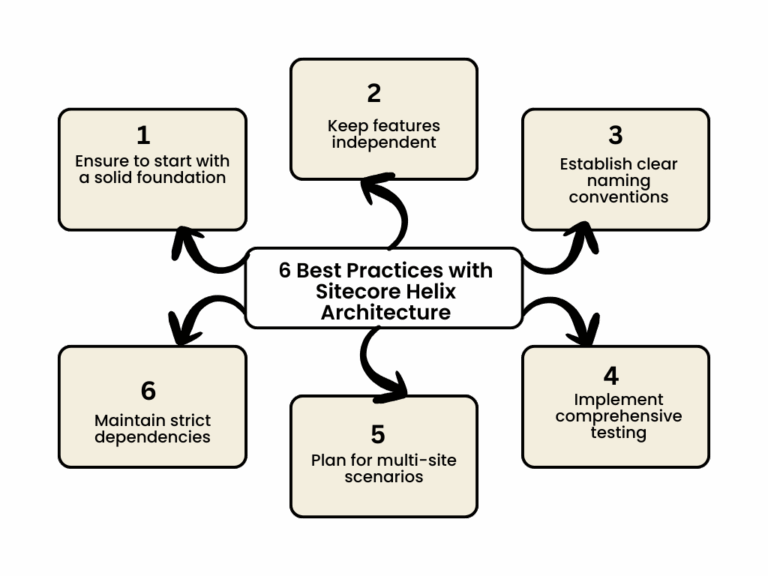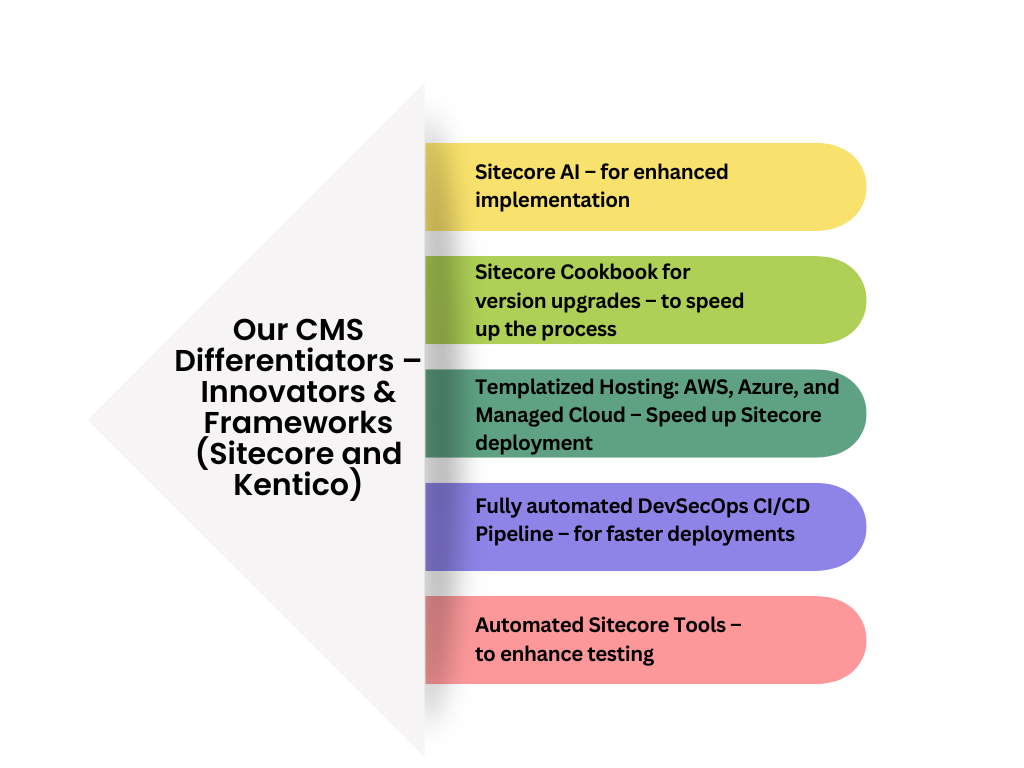
Sitecore Helix Architecture: A Layered and Modular Development Standard
Table of Contents
Introduction
In today’s rapidly evolving digital landscape, enterprises require robust, scalable, and easily maintainable content management systems (CMS). Enterprises, in their quest to deliver seamless digital experiences, need CMS platforms that are powerful, scalable, and easy to manage. This is where Sitecore Helix Architecture steps in, providing a robust framework that transforms how large organizations build, manage, and evolve their Sitecore solutions. Sitecore Helix is a set of design principles and development guidelines introduced by Sitecore to promote modular, maintainable, and scalable solutions on the Sitecore Experience Platform.
Sitecore Helix Architecture has emerged as the gold standard for building enterprise-grade Sitecore implementations that can adapt to complex business requirements while maintaining code quality and developer productivity. Sitecore Helix is a collection of recommended practices and conventions for the solution architecture of Sitecore product implementations. Moreover, Helix is a set of official guidelines and recommended practices from Sitecore, wherein each component is independent, reusable, and designed for a specific purpose, empowering enterprises and businesses to construct complex digital ecosystems with unprecedented agility.
Key Facets of Sitecore Helix Architecture
Sitecore Helix architecture is modular and is based on breaking down the solution into effective logical modules. Each module is focused on a single responsibility, making the system easier to understand, develop, test, and extend. The main purpose of Helix is to provide developers with efficient guidelines to help them build future-proof solutions that are easy to maintain.
The Sitecore Helix is characterized by three elements:
- Layers
- Coupling
- Cohesion
1. Layers: In Sitecore Helix architecture, a layer refers to a logical grouping of code and functionality based on its responsibility and role within the solution. Layers are used to enforce modular development, separation of concerns, and maintainability. Layers further consist of three main divisions:
Foundation Layer: This layer holds the low-level, cross-cutting concerns such as logging, data access, or indexing that are shared across multiple features. This is the bedrock layer that contains low-level and cross-cutting concerns that are fundamental to the entire solution. Let us think about some of the shared services, base templates, common utility functions, and integrations with core enterprise systems (CRM, ERP, etc.) wherein any change here significantly impacts many other layers for reusability and is named as Foundation layer.
Feature Layer: This layer contains the reusable business features like navigation, search, news, etc; wherein each feature is self-contained and independent. Each module in this layer represents a specific, self-contained business feature such as a news listing, product catalog, search functionality, or a promotions module. Specifically, these Feature modules should be independent of each other, promoting isolated development and deployment.
Project Layer: This layer contains project-specific code and configuration, such as page types and layouts. It orchestrates features but doesn’t contain business logic. This layer brings everything together, more like the composition layer, where you can assemble the features and foundation elements to create specific websites, microsites, or digital channels. It provides the overall context, layouts, and site-specific configurations, typically containing minimal custom code.
2. Coupling: It refers to how modules relate to each other referring to the dependencies between the modules. Typically, low coupling indicates modules are independent and changes in one do not affect others.
3. Cohesion: As the name suggests means ‘sticks’ something together, referring to how closely related are the functions within a module. While Sitecore Helix promotes low coupling between the modules, it also encourages high cohesion within each module. High cohesion refers to one module taking up single responsibility.
What is the Golden Rule of Helix?
- Dependencies flow downwards.
- Project modules can depend on Feature and Foundation modules.
- Feature modules can depend only on Foundation modules.
- Foundation modules can only depend on other Foundation modules.
- This strict hierarchy ensures clarity and reduces complexity.
Benefits of Sitecore Helix Architecture for Enterprises and Businesses
There are profound benefits for enterprises and businesses with Sitecore Helix architecture. Some of them have been given below:
Development-based
- Accelerated development cycles: With clear boundaries and reduced interdependencies, the development teams can work in parallel on different features. This fosters true agile development, ensuring faster iterations and quicker time-to-market for new functionalities, and in enabling better digital experiences.
- Enhanced code reusability: Helix architecture’s flexibility to design features as independent modules ensures, they can be easily reused across multiple websites, brands, or even future projects. This saves significant development time and cost, promoting consistency across your digital properties with enhanced code reusability.
- Improved code quality and testing with modular code: Helix enforces architectural patterns that naturally lead to better code quality. The clear separation of concerns makes code more readable, testable, and maintainable. This is particularly valuable for enterprises that need to maintain solutions over many years. Modular code is easier to test, both in isolation and as part of the overall system. The modular nature of Helix makes it easier to implement comprehensive testing strategies. Each feature can be unit tested in isolation, and integration tests can focus on specific interactions between modules.
- Easier upgrades and future-proofing: Sitecore’s core product evolves and Helix makes the upgrades easier, as the changes are isolated to specific modules, reducing the risk and effort associated with the platform updates. The Helix architecture ensures your solution is flexible enough to embrace future Sitecore innovations.
Scalability-based
- Unmatched scalability and maintainability: As enterprises’ digital footprint grows, so does the complexity of the business. Helix breaks down your solution into manageable, independent modules wherein new features can be added without impacting existing ones. Further, maintenance becomes more focused and less prone to ripple effects across the entire platform with unmatched scalability and maintainability.
Team-based
- Improved team collaboration: Helix provides a standardized structure that developers can understand and follow, regardless of their experience level. This consistency simplifies onboarding for new team members and facilitates seamless collaboration across geographically located teams. Large enterprise projects typically involve multiple development teams working simultaneously, wherein Helix architecture, with its well-defined boundaries, enables teams to work independently on different features without conflicts.
- Reduced technical debt: By enforcing Helix best practices around modularity, low coupling, and clear dependencies, it helps prevent the accumulation of technical debt. This translates to a healthier codebase, fewer bugs, and lower maintenance costs in the long term with low maintenance.
Business outcomes
- Better business-centricity: Helix encourages developers to think about features in terms of business capabilities, not just technical components. This fosters better communication between technical and business teams, ensuring the digital platform truly reflects and supports the strategic business objectives of the enterprises.
- Faster Time-to-Market: With Sitecore Helix architecture, once the initial foundation is established, new features can be developed and deployed more quickly for businesses. The Helix modular structure allows for parallel development and reduces the complexity of integrating new functionality, enabling better digital experiences and quicker outcomes with faster time-to-market.
Sitecore Helix Architecture – Key Benefits Overview
- Reusability
- Low complexity
- Low maintenance
- Easy troubleshooting
- Improved productivity
- Significant cost reduction
6 Best Practices with Sitecore Helix Architecture

- Ensure to start with a solid foundation: It is essential to invest significant effort in designing and implementing the foundation layer. This layer will be used throughout the solution such that it will be robust, well-tested, and thoroughly documented.
- Keep features independent: It is effective to create dependencies between feature modules. If features need to communicate, it is preferred to use events, dependency injection, or loose coupling patterns.
- Establish clear naming conventions: Consistent naming conventions across all layers make the codebase more navigable and maintainable. This best practice is critical for large enterprise solutions working with multiple teams.
- Implement comprehensive testing: Thorough testing should be implemented by taking the complete advantage of the modular structure at each layer. It is critical to perform unit tests for foundation modules, feature tests for business logic, and integration tests for the complete solution to derive effective results.
- Plan for multi-site scenarios: Many enterprises need to support multiple websites or brands, and design the Helix structure with multi-site requirements in mind from the initial phases.
- Maintain strict dependencies: It should be noted that higher layers (Project → Feature → Foundation) should be the order to reference lower layers, but never the other way around.
Best Applications of Sitecore Helix
Helix is widely adopted across enterprise Sitecore implementations and is ideal for teams looking to:
- Scale up development across global teams
- Improve DevOps and CI/CD pipelines
- Simplify Sitecore upgrades and platform maintenance
- Drive architectural consistency across multiple Sitecore instances
Conclusion
Sitecore Helix Architecture represents a mature, enterprise-ready approach to building scalable solutions. While it requires initial investment in planning, training, and setup, the long-term benefits far outweigh the costs for enterprise organizations. The combination of improved maintainability, team productivity, code quality, and scalability makes Helix more beneficial for enterprises. Organizations that adopt Helix principles early in their Sitecore journey will find themselves better positioned to adapt to changing business requirements and take advantage of new opportunities.
While the benefits are compelling, adopting Helix, especially for legacy Sitecore solutions, might require an initial investment in refactoring and balancing cultural shifts. Thus, for enterprises aiming to build robust, future-proof, and highly performant digital experiences on Sitecore, Helix is just not a recommendation but should be a strategic imperative. Thus, enterprises need to leverage the services of Sitecore Helix architecture experts to take the full benefits of its implementation.
Why Choose Adroitent as Your Preferred Partner for Sitecore Implementations?
Adroitent specializes in developing, supporting, and upgrading Content Management Solutions (CMS) across a broad spectrum of platforms, including Sitecore, Kentico, and other third-party tools and custom technology stacks. With a focus on creating tailored CMS that aligns with specific business goals, Adroitent leverages the advanced capabilities of these platforms to deliver scalable and effective solutions.
An Overview of Content Management Services
Sitecore and Kentico CMS Services
- Consulting
- Development and Implementation
- Enhancement, Support, and Migration
- Content Management and Optimization
- Enterprise Integration
- Maintenance and Support
- Upgradation and Re-hosting
Our CMS Differentiators – Innovators & Frameworks (Sitecore and Kentico)

Our Implementation Expertise with Sitecore Helix Architecture to Global Customers
At Adroitent, our Sitecore-certified developers and architects bring unmatched expertise in implementing Helix-compliant, scalable solutions tailored for enterprise needs.
An Interesting Business Use Case Implemented for a Leading Healthcare Content Publisher
For a leading healthcare content publisher, Adroitent helped migrating their legacy SharePoint-based platform into a Sitecore Helix-compliant, headless, modular, and multisite architecture to support 100+ journal microsites, each with localized branding, content, and functional customizations.
Highlights of the Sitecore Implementation:
- Modular Architecture: Leveraged Helix to separate reusable components (e.g., search, article listings, and author profiles) into feature modules, enabling rapid development and rollout of new journals.
- Scalable Multisite Structure: Designed a robust multisite setup allowing each journal to operate independently while sharing core functionalities through Foundation modules.
- Localized Branding & Layouts: Enabled per-site customization with a single code base using Helix-aligned project layers and headless rendering strategies.
- Headless Enablement: Adopted Sitecore JSS to deliver content to front-end frameworks. This solution empowered the customer to onboard new journals faster, and future-proof their content delivery model and enhanced their global scalability.
